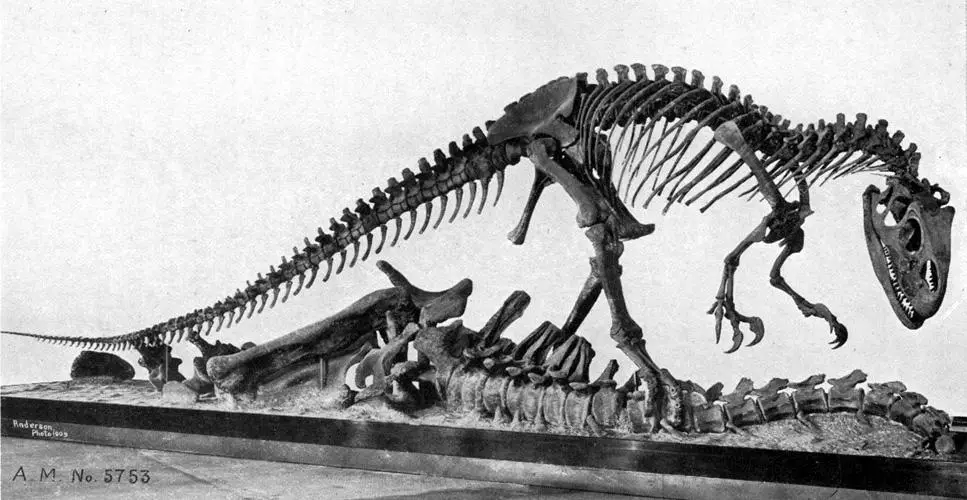A 1915 depiction of Allosaurus, specimen AMNH 5753, as seen in William Diller Matthew’s publication on dinosaurs, is accessible for public use via Project Gutenberg and Wikimedia Commons under the CC0 license.
Recent simulations indicate that the ability to utilize dead prey could have been essential for survival in the Jurassic period.
Newly published findings in PLOS ONE, a journal accessible to all, indicate that carnivorous dinosaurs may have evolved to make use of the plentiful remains of massive creatures. The research team, including Cameron Pahl and Luis Ruedas from Portland State University in Oregon, and their peers, suggest that the remains of huge sauropod dinosaurs could have been a critical food source for their large predatory counterparts.
Analysis Using an Agent-Based Model
Predatory dinosaurs existed in ecosystems abundant with potential food, both living and dead. The study postulates that the remains of giant sauropods may have been an important food provision for these predators.
The hypothesis was examined through an agent-based model, simulating a prehistoric ecosystem reflective of the Jurassic-era Morrison Formation, with large predators such as Allosaurus and massive sauropods, along with an endless number of huntable stegosaurs.
The model allocated to the carnivores—meant to emulate allosaurs—specific traits enhancing their scavenging or hunting capabilities to gain energy from various meat sources, representing either live prey or the carcasses of sauropods.
The evolutionary success of these traits was assessed in the model, showing that in environments where abundant sauropod remains were present, scavenging yielded greater benefits than active hunting. This suggests that predators in these settings could have developed specialized abilities for locating and utilizing large prey remains.
Adaptation of Scavenging Traits
The researchers underscore that this model is a simplified representation of a highly intricate system and acknowledge that integrating additional variables, such as more dinosaur species or details about the dinosaurs’ life cycles, could modify the outcomes. However, they believe that such models can enhance our comprehension of how the presence of dead prey could affect the evolutionary path of predators.
The researchers further state, “Our evolutionary simulation suggests that large theropods like Allosaurus may have adapted to depend primarily on sauropod carcasses as a food source. Despite available living prey, natural selection favored scavenging behaviors due to higher survival rates in those displaying such traits. It is hypothesized that allosaurs likely capitalized on the death of sauropods during dry periods, consumed their remains, stored the surplus fat in their tails, and followed this cycle seasonally. Logically, this theory is plausible since a single sauropod carcass could sustain approximately 25 allosaurs for an extended period, and sauropods were commonly the most prevalent dinosaurs in their habitats.”
For further reading: “How fat storage and other adaptations influenced large theropod foraging ecology” by Cameron C. Pahl and Luis A. Ruedas, dated 1 November 2023, published in PLOS ONE.
DOI: 10.1371/journal.pone.0290459
Table of Contents
Frequently Asked Questions (FAQs) about carnivorous dinosaurs scavenging
Could Jurassic carnivores have primarily fed on sauropod remains?
Recent studies suggest that large predatory dinosaurs like Allosaurus may have adapted to rely on the carcasses of enormous sauropods as a significant food source.
What does the agent-based model reveal about dinosaur survival strategies?
The model indicates that scavenging for sauropod carcasses was more advantageous than hunting, potentially leading to the evolution of specialized scavenging traits in large carnivores.
How does carrion availability impact the evolution of predators?
The simulation findings imply that abundant carrion, like sauropod remains, could have significantly influenced the development of scavenging behaviors in predatory dinosaurs.
Do the study’s findings apply to all predatory dinosaurs?
While the study focuses on large theropods such as Allosaurus, it suggests that similar scavenging strategies could have been advantageous for other predators in the same ecosystem.
How might this research alter our understanding of dinosaur ecology?
This research provides insight into the ecological dynamics of the Jurassic period, highlighting the possible reliance of predators on carrion and how this behavior shaped their evolutionary adaptations.
More about carnivorous dinosaurs scavenging
- Jurassic Predatory Dynamics
- Allosaurus Feeding Behaviors
- Carrion in Dinosaur Ecosystems
- Evolution of Scavenging Dinosaurs
- Agent-Based Models in Paleontology



5 comments
agent based models sound fancy but can they really tell us that much about dinosuars, seems like guesswork to me.
interesting study, but how can we be sure what happened millions of years ago? its all speculation isn’t it?
so if i get this right, the allosaurus was like the vulture of the jurassic period? kinda cool to think about them waiting around for a free lunch.
I read the article but didnt see where it talks about how they figured out the dino’s behavior, did they have like dino cameras back then lol.
gotta say i’m not convinced that these big dinos just ate dead stuff all the time wasn’t the point of those big teeth to hunt.